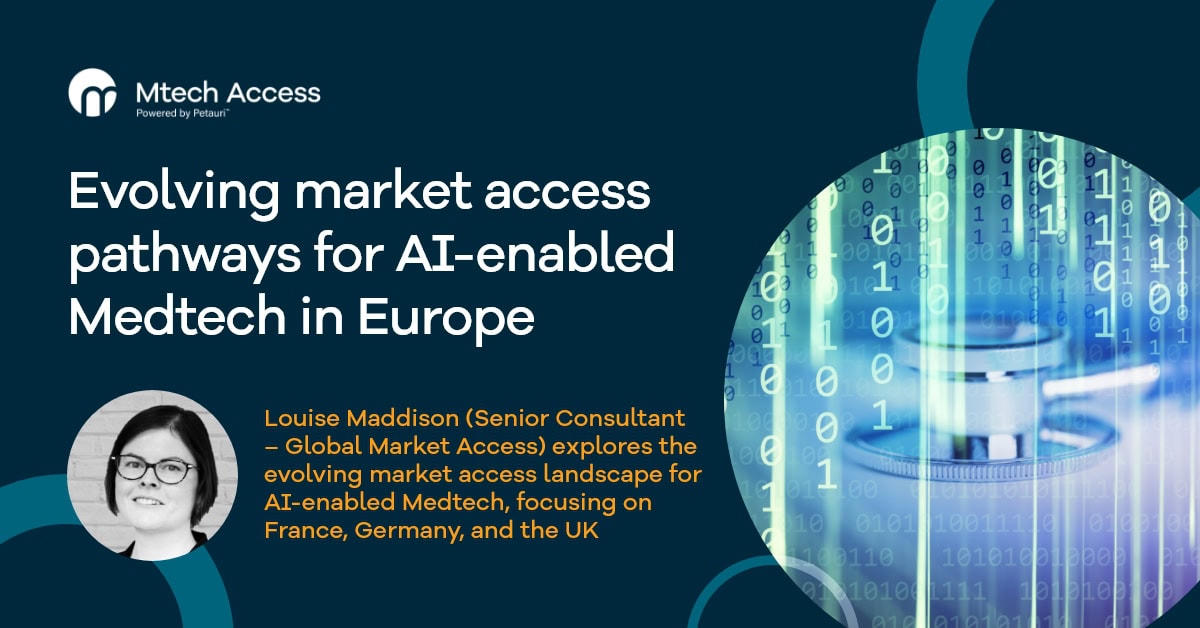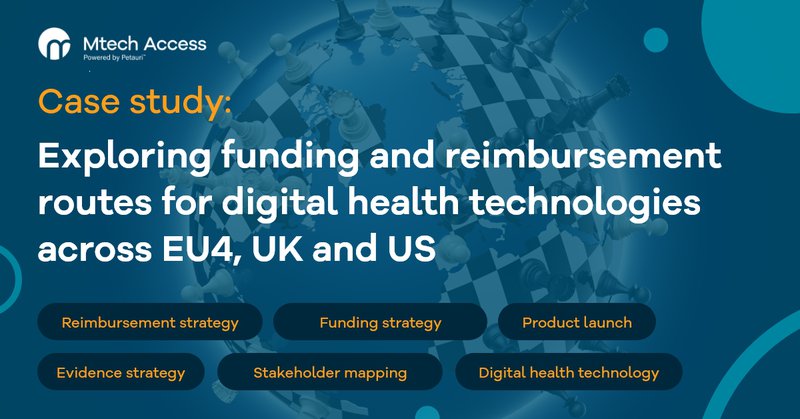Evolving market access pathways for AI-enabled Medtech in Europe
With the rapid acceleration of artificial intelligence (AI)-enabled technology and its use in the development of innovative medical devices, the landscape of regulation and reimbursement of this technology is ever evolving and changing. As governments look to implement AI health-related applications to transform the provision of healthcare, there are several schemes to support access to digital health.
In Europe, there have recently been several legislative changes. For example, the European Union (EU) AI Act, and the introduction of reimbursement pathways at the national level to support access to digital health technology. In this article, Louise Maddison (Senior Consultant – Global Market Access, Mtech Access) explores the evolving market access landscape for AI-enabled Medtech, with a particular focus on the key European markets of France, Germany, and the UK.
The path to market access involves multiple stakeholders, each playing a crucial role. Patients represent the basis of unmet need, and physicians want to use the technology and their data to address this unmet need. Payers need to be convinced of the clinical and economic evidence supporting the new technology. Additionally, medical societies and coding agencies are essential to the process. Regulators are responsible for granting clearance and marketing authorisation. Currently, many are revising their frameworks to adequately address the unique challenges posed by AI.
EU AI Act
From August 2024, the AI Act came into force across the EU, which has additional implications for digital health manufacturers beyond the Medical Device Regulation (MDR) (1-3). The AI Act provides a framework for AI systems based on a risk-based approach and applies to all industries, to ensure AI systems used in the EU are safe, transparent, traceable, non-discriminatory, and environmentally friendly.
‘High-risk AI systems’, such as AI-based medical software, must comply with strict requirements, including systems for risk mitigation, robust datasets, and clear user guidance. Many of which overlap with the current rigorous requirements of conformity assessment under the MDR. It is important to note that the risk levels between the MDR and AI Act are not equivalent. Indeed, AI-enabled technology, which requires conformity assessment by a notified body and includes devices classed as ‘medium risk’ under MDR, would automatically be ‘high risk’ under the AI act.
The AI Act will become fully applicable from August 2026, but high-risk AI systems, such as medical devices, will have an extra year to comply. Medical device manufacturers will need to act now to ensure that their regulatory plans meet the AI Act requirements.
Additionally, the transition from Medical Device Directive (MDD) to MDR within the EU means that there is increased evidence demonstration of device performance and safety prior to medical device approval and post-market follow-up, as well as improving transparency and traceability of data (4). From May 2024, devices may only be marketed under MDR certification and next year devices with MDD certification may no longer be sold.
AI-enabled medical devices in the UK
As part of the UK’s medical technology strategy, a 5–10 year plan, the Medicines and Healthcare products Regulatory Agency (MHRA) have been establishing a streamlined pathway for Medtech innovation (5). Recently, there have been several initiatives with a focus on AI to set the UK apart from other markets as the place for development and commercialisation of healthcare technologies.
AI Airlock
A regulatory sandbox aimed at understanding and mitigating risks associated with Software as a Medical Device/Artificial Intelligence as a Medical Device (SaMD/AIaMD) prior to placing on the market (6). The objective is to identify challenges and share findings to aid regulatory and funding efforts for AI as a medical device. Creating sandboxes enables AI innovations to be explored within a contained space outside of the existing regulatory framework and allows regulators to collect important insights before deciding on further regulatory action. As part of a pilot project involving the National Health Service (NHS) and Team UK Approved Bodies (AB), 4–6 projects will be selected to test regulatory issues in clinical settings.
AI low-risk products
Similar to the EU, the UK uses a risk-based classification system for medical devices, and the higher the risk class, the greater the scrutiny required (7). However, many AI-enabled healthcare products currently in the lowest risk classification, where an independent conformity assessment is not required, will be up-classified. It is expected that this will provide users and patients with additional protection through greater scrutiny during the product’s lifecycle.
Additionally, the MHRA has published 10 guiding principles jointly with the US Food and Drug Administration (FDA) and Health Canada, Good Machine Learning Practice for Medical Device Development: Guiding Principles, to promote good practice for all medical devices.
International recognition of medical devices in the UK
The MHRA has also announced plans to incorporate approvals from outside the UK alongside United Kingdom Conformity Assessment (UKCA) marking until June 2030 (8). A comparable regulator countries framework would recognise approvals from the FDA, EU member states, Health Canada, and the Australian Therapeutic Goods Administration (TGA). Reliance on other regulators will enable faster approvals by the MHRA. The operational aspects are under development with industry and designated approved bodies, for AIaMD there will be a review of pre-market data. It is expected that the final version of the framework will come into force in 2025.
Government recognition of the benefits of AI to healthcare
Governments are increasingly recognising the benefits that AI can bring to drive efficiency in healthcare. In Germany, the national lung cancer early detection programme will be implemented with AI used to assist radiologists in reviewing low-dose computed tomography images (9). AI can support such large volume screening programmes with workflow, diagnostics, and data analysis. The UK government is also exploring how the NHS can use AI to transform the health and social care settings, as well as improvements to regulatory processes, e.g. use of machine learning to streamline document assessments by the MHRA (7, 10).
Reimbursement for digital healthcare
Medtech manufacturers targeting different markets must evaluate the current market access pathways in each country to achieve reimbursement, as pathways are evolving to support AI-based healthcare innovations.
AI reimbursement in Germany
In Germany, there are fast-track options to support patient access to new technologies. The Digital Healthcare Act in 2019 introduced Digital Health Applications/Digital Nursing Applications (DiGA/DiPA) fast-track pathways, which provide expedited regulatory approval and reimbursement by statuary health insurance (11, 12). Applications to the DiGA/DiPA fast track have included psychological interventions, bones and joint health, and cardiology.
Building on this, the German government passed the Digital Act (DigiG) last year, which aimed to support the use of digital solutions and improve access to health data, including the expansion of the DiGA to higher risk medical technology, with the overall aim of improving everyday care in Germany (13).
AI reimbursement in France
In France, similar to the German DiGA, the Early Access to Reimbursement for Digital Devices (PECAN) fast-track scheme was established in 2023 to enable the temporary reimbursement (1 year) of digital health technologies prior to permanent reimbursement (14). This allows time for manufacturers to collect additional clinical data and finalise the submission dossier for permanent reimbursement.
AI reimbursement in England
Ongoing change and innovation are providing opportunities for accelerated access and reimbursement in England. One such approach is the Early Value Assessment (EVA) for digital products, devices, and diagnostics, which aims to support rapid access to technologies that address national unmet needs (e.g. early cancer detection) (15). The EVA is open to digital health technologies or other medical technologies that are European Conformity (CE) or UKCA marked, which require further data collection before recommendation; digital technologies must also have Digital Technology Assessment Criteria (DTAC) approval. The EVA supports manufacturers with the production of evidence required for a full National Institute for Health and Care Excellence (NICE) appraisal, as well as recommendation on future use in the NHS.
To learn more about reimbursement pathways for medical technology, we offer a free guide for US and key European markets.
Changing market access landscape
To bring AI-enabled medical technology to market it is essential to understand:
- The various approval and reimbursement routes relevant to your product
- The evidence required to demonstrate both clinical and economic value
- Where it will be positioned in the treatment pathway
We can offer support to bring your healthcare innovation to market and throughout the product lifecycle by providing commercialisation strategy, evidence synthesis and analysis, as well as payer value communications. To understand more about how we add value to your digital health pipeline, read this case study or drop us an email at info@mtechaccess.co.uk.
This article was originally published on the Mtech Access website at: https://mtechaccess.co.uk/evolving-market-access-pathways-for-ai-enabled-medtech-in-europe/
References
- European Commission. AI Act enters into force. 2024. Available from: https://commission.europa.eu/news/ai-act-enters-force-2024-08-01_en. Accessed on: 20th August 2024.
- European Parliament. EU AI Act: first regulation on artificial intelligence. 2024. Available from: https://www.europarl.europa.eu/topics/en/article/20230601STO93804/eu-ai-act-first-regulation-on-artificial-intelligence. Accessed on: 20th August 2024.
- European Commmission. Artificial Intelligence – Questions and Answers. 2024. Available from: https://ec.europa.eu/commission/presscorner/detail/en/QANDA_21_1683. Accessed on: 20th August 2024.
- European Commission. Questions and Answers: Commission proposes an extension of the transitional periods for the application of the Medical Devices Regulation. Available from: https://ec.europa.eu/commission/presscorner/detail/en/qanda_23_24. Accessed on: 20th August 2024.
- Department of Health & Social Care. Medical technology strategy. 2024. Available from: https://www.gov.uk/government/publications/medical-technology-strategy/medical-technology-strategy#priority-3-enabling-infrastructure-1. Accessed on: 20th August 2024.
- MHRA. AI Airlock: the regulatory sandbox for AIaMD. 2024. Available from: https://www.gov.uk/government/publications/medical-technology-strategy/medical-technology-strategy#priority-3-enabling-infrastructure-1. Accessed on: 20th August 2024.
- MHRA. Impact of AI on the regulation of medical products. 2024. Available from: https://www.gov.uk/government/publications/impact-of-ai-on-the-regulation-of-medical-products/impact-of-ai-on-the-regulation-of-medical-products. Accessed on: 20th August 2024.
- MHRA. 2024. Statement of policy intent: international recognition of medical devices. Available from: https://www.gov.uk/government/publications/implementation-of-the-future-regulation-of-medical-devices/statement-of-policy-intent-international-recognition-of-medical-devices. Accessed on: 20th August 2024.
- Ward P. Lung cancer screening arrives across Germany. 2024. Available from: https://www.auntminnieeurope.com/clinical-news/ct/article/15678766/lung-cancer-screening-arrives-across-germany. Accessed on: 20th August 2024.
- NHS England. The NHS AI Lab. 2024. Available from: https://transform.england.nhs.uk/ai-lab/. Accessed on: 20th August 2024.
- Federal Ministry of Health. Driving the digital transformation of Germany’s healthcare system for the good of patients. 2019. Available from: https://www.bundesgesundheitsministerium.de/en/digital-healthcare-act. Accessed on: 20th August 2024.
- Federal Institute for Drugs and Medical Devices. DiGA and DiPA. 2024. Available from: https://www.bfarm.de/EN/Medical-devices/Tasks/DiGA-and-DiPA/Digital-Health-Applications/_node.html. Accessed on: 20th August 2024.
- Federal Ministry of Health. Law to accelerate the digitization of the healthcare system (Digital Law – DigiG). 2023. Available from: https://www.bundesgesundheitsministerium.de/ministerium/gesetze-und-verordnungen/guv-20-lp/digig. Accessed on: 20th August 2024.
- Digital Early Support (PECAN). Available from: https://gnius.esante.gouv.fr/fr/financements/fiches-remboursement/prise-en-charge-anticipee-numerique-pecan#:~:text=Le%20dispositif%20cible%20les%20dispositifs,un%20remboursement%20de%20droit%20commun. Accessed on: 21st August 2024.
- NICE. Early Value Assessment (EVA) for Medtech. Available from: https://www.nice.org.uk/about/what-we-do/eva-for-medtech. Accessed on: 21st August 2024.





